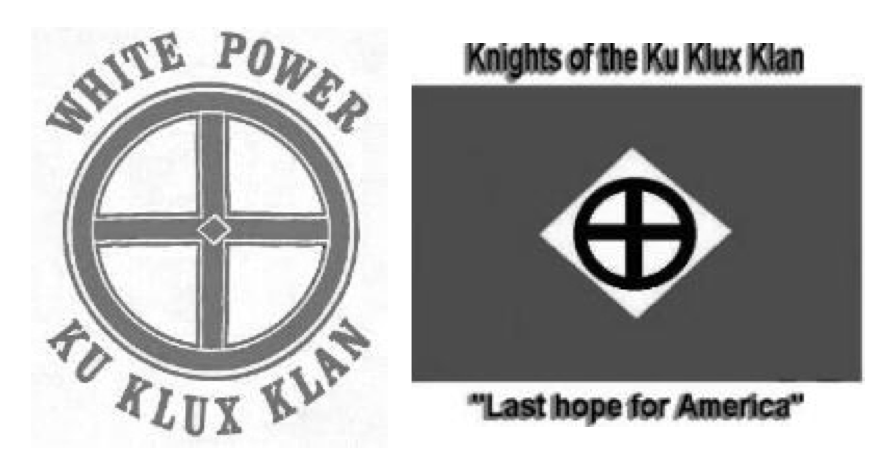"Droodle Me This ... ": Pictorial Declarations and the American Dream Maria Teresa Agozzino
I would like to share a parenthetical note before I come to my final analysis. Ku Klux Klan insignia shown in Figures 11 and 12 bears striking similarities in form to "Black man down a well" droodle designs, and I would speculate that these traditional droodles arose in response and in resistance to KKK emblems. Breaking out of the frame is dependent on commonly understood limits (Goffman 345), and as sites of resistance, droodles, like some graffiti, pit wit against authority and provide relief from hostility, aggression (Dudden 11), and transgression; artistic protest against hegemony (Cresswell 164-65, 170).
In honor of the late great American folklorist Alan Dundes, I cannot possibly conclude without first offering a psychoanalytical interpretation of the "Black man down a hole" cycle. Dundes may well have declared that the Klansmen's choice of persecution was in fact a ritualized act of ejection by penetration -- an inverted projection in response to the pervasive fear of the legendary over-sexualized Black man;  his power over white women and corresponding emasculation of white men -- and thus the Christian white man's vicious cycle of demonization and justification against a constructed perpetrator.
his power over white women and corresponding emasculation of white men -- and thus the Christian white man's vicious cycle of demonization and justification against a constructed perpetrator.
Figures 11 and 12: Ku Klux Klan Emblems and Mottos (Ku Klux Klan).
Conclusion
In a multicultural society, there are as many versions of the American dream as there are people aspiring to it. Whether a City upon a Hill, the almighty dollar, or racial equality (Warshauer), cultural myths, dreams, and nightmares are all reflected in a folk's lore. While folklore has no agenda, as we have seen, folklore "tells it like it is or at least tells it as some people think it is or as they would like it to be" (Dundes, "Folk & Lore" 2). A brief examination of droodles clearly illustrates that we can draw an analogy between microcosmic manifestations and macrocosmic ideologies; the textually specific iconic code (Roemer, "Beholder" 178) signals a culturally specific code. Price's innocent "American expressions of ability and imagination" (Rich Sardine 5) are in fact emergent and evocative views of a dynamic American social, economic, religious, and political environment▄a fertile set of self-sustaining and cross-pollinating data. In applying a simple Dundesian premise to an unsophisticated genre, I hope I have demonstrated an effective, enduring, and relevant interdependence between the fields of Folkloristics and American Studies.
Maria Teresa Agozzino has a Ph.D. in Folklore and Celtic Studies from the University of California, Berkeley, where she served as Head Reader for Alan Dundes from 1999-2004 and as Head Archivist from 2000 to 2004. She has taught folklore and American Studies courses at UC Berkeley and California State University, East Bay. Her publications include "Welsh Calennig and Greek Kalanda: Begging in the New Year," Cosmo: The Journal for the Traditional Cosmology Society 19 (2005): 21-45, "Ysbryd y Werin: An Overview of Celtic Folklore Scholarship," The Folklore Historian 22 (2005): 13-33, and "First Come, First Served: Investigating Sir John Rhys' 'Essential Connexion' between Celtic New Year Customs." Studi Celtici: An International Journal of History, Linguistics, and Cultural Anthropology 2 (2003). This paper evolved from a guest lecture presented to an introductory American Studies course at UC Berkeley in fall 2005. She is much obliged to Christine Palmer for the opportunity.
